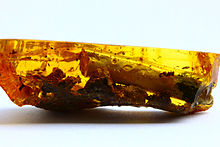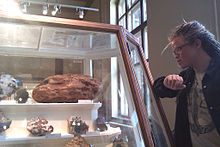resinite
(Amber occurring in coal seams is also called resinite, and the term ambrite is applied to that found specifically within New Zealand coal seams.)
inclusions
(animal and plant material)
Inclusions
Baltic amber with inclusions
Such inclusion of other substances can cause amber to have an unexpected color. Pyrites may give a bluish color. Bony amber owes its cloudy opacity to numerous tiny bubbles inside the resin.[26] However, so-called black amber is really only a kind of jet.
In darkly clouded and even opaque amber, inclusions can be imaged using high-energy, high-contrast, high-resolution X-rays.[27]
This is a list of types of amber.
A
huge piece of Baltic amber (9,7 kg) - This is one of the largest pieces
of Baltic amber ever found. The piece is stored at the Natural History
Museum in Berlin.
True ambers
- Baltic amber - the most common amber variety, found along the shores of a large part of the Baltic Sea.
- Burmese amber - also known as burmite, is a Cretaceous age amber up to 99 million years old found mainly in the Hukawng Valley, Kachin State, Myanmar (Burma). The most common amber containing insect inclusions of the Cenomanian.
- Dominican amber - nearly always transparent, and having a higher number of fossil inclusions than Baltic amber.
- Blue amber - a rare color variation, most commonly is found in the Dominican Republic.
- Mexican amber - found mainly in Chiapas in Mexico, roughly contemporary with Miocene era Dominican amber, and produced by the extinct Hymenaea mexicana tree, a relative of the Hymenaea protera tree responsible for producing Dominican Amber.
- New Jersey amber - Found on the Atlantic coastal plain of North America, dated to the Cretaceous, Turonian.
- Rovno amber - Found in the Rovno region of Ukraine, of similar age to Baltic amber, and sharing many species.
- Sri Lankan amber - found in sea coast in a very small quantity also called Indian amber or Indian sea amber .


No comments:
Post a Comment